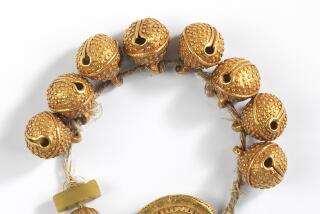Alan Donovan loves Africa’s arts and crafts
- Share via
Reporting from Nairobi, Kenya — — To find the house that Alan Donovan built, drive a few miles southeast from the heart of Kenya’s traffic-snarled capital and pull onto an abruptly quiet road toward the savanna. The African Heritage House, which overlooks the great, still plain of Nairobi National Park, is both a trove of a continent’s aesthetic richness and a mausoleum of its extinct wonders.
Donovan, 70, was born in Colorado and attended UCLA but has lived in Africa since the U.S. State Department sent him to Nigeria as a relief officer in 1967. His home, billed as the most photographed on the continent, has a turreted facade echoing the mosques of Mali and a tower bearing the geometric designs of a Nigerian emir’s palace.
Inside are a garden courtyard, nine distinct rooms and 6,000 pieces of arts and crafts reflecting a lifetime’s immersion in Africana as a collector, dealer and patron. Every detail is carefully arranged, from the sinks of Moroccan brass to a bathtub of Swahili plasterwork. Donovan shows the house by appointment and takes reservations for overnight guests.
Tour the place with the owner, and the recurring theme is loss. Here is a wall of exquisite beadwork from the Kamba of Kenya. “They’ve become modern, globalized,” Donovan says. “So they’re no longer interested in beadwork.”
Here are appliqued masquerade costumes from the Ibo of Nigeria. “You couldn’t get these anymore,” he says.
An elegant wooden grave marker from Madagascar. “They’re all gone.”
Ceremonial daggers from the Bakuba people of the Congo. “You can’t find these anymore.”
“There’s hardly anywhere to buy this stuff now,” says Donovan, sounding more than a little crestfallen. “They’ve all stopped. It’s all coming to an abrupt halt. Especially the young Kenyans. They don’t have any idea of their culture at all.”
In the early 1970s, soon after leaving the State Department, Donovan opened the African Heritage Gallery in downtown Nairobi, and tourists stretched down the block to buy treasures he’d collected or commissioned. His business partner was Joseph Murumbi, former vice president of Kenya and a collector.
By Donovan’s reckoning, the company became the largest exporter of pan-African crafts in the world, with some 500 full-time employees in Nairobi and 51 worldwide outlets, including one in Palo Alto. He toured 20 African countries a year on buying trips.
The decline of the business began in the early 1990s, abetted by Kenya’s political volatility and what Donovan calls “poor governance” under then-President Daniel arap Moi. Ethnic violence raged, crime spiraled out of control, and hotel owners were advising their guests — with good reason — that it was dangerous to stroll the streets of Nairobi. Walk-in traffic vanished. “People didn’t want to come downtown at all,” he says.
The Al Qaeda bombing of the U.S. Embassy in Nairobi in 1998 scuttled a long-planned sale of his business, and in 2003, amid fears of further terrorism, British Airways temporarily suspended flights to Kenya.
“That ended me. That pushed me into bankruptcy,” Donovan says. “I went through a terrible depression.” Liquidators shut him out of his shop. Gesturing around his home, he says, “This is a fraction of what we had.”
Donovan is deeply ambivalent about the Western influence on Africa, which he blames in part for the decline of traditional African arts. “The missionaries came in and told Africans these things were devil worship, so a lot of Africans think these things are witchcraft and bad,” he says, adding: “Everywhere in Africa, they want to be Americans. This is like the 51st state.”
He speaks of a Kenyan boy who emerged from four years of public-school education despising his family’s goat-herder lifestyle and coveting emblems of Western civilization. He was eventually jailed for stealing a radio from a Peace Corps volunteer. “It was too big a temptation,” Donovan says. “I thought, ‘If you’re just half in one world, and half in another, you’re really nowhere.’”
William Bellamy, U.S. ambassador to Kenya from 2003 to 2006, says he became aware of Donovan when he received “an indignant letter” in which Donovan complained about travel warnings the U.S. State Department had issued regarding Kenya, amid fears of terrorism. The warnings were crippling tourism.
“I remember being slightly irritated by this,” Bellamy says of the letter, though he said he soon came to like Donovan and share his frustration. When Bellamy left as ambassador, he held his farewell party at Donovan’s house. They sat on the roof at sunset overlooking the national park. “My friend turned to me and said, ‘This is the most magical moment of our lives,’” Bellamy says. “That house, it’s like being in a dream.”
Donovan’s challenges have been compounded, Bellamy says, by the relatively small investment the Kenyan government has made in the arts. “His love of African art really didn’t have much of an official echo,” Bellamy says. “I’m sure there were times Alan thought he was fighting kind of a lonely battle.”
Michael Ranneberger, who recently departed as U.S. ambassador to Kenya, says the amount of money the Kenyan government spends on the arts is “woefully inadequate,” adding: “In general, East African artists are a bit underappreciated.” He has been a lunch and dinner guest at Donovan’s home many times. “He’s maintained an incredible spirit, despite the troubles he’s faced,” Ranneberger says. “To me, that’s a triumphant thing.”
Herbert “Skip” Cole, a specialist in African art who taught art history at UC Santa Barbara for 35 years, says there remains a thriving market in African crafts, with thousands of workshops across the continent creating jewelry and other products. “A lot of African people have been saved from starvation by turning out these artifacts,” says Cole, crediting Donovan as a catalyst in the industry.
But with the waning of traditional African culture, he says, craftspeople often make the products for the market rather than for their own communities.
“It leads to the diminution of quality. It leads to the paucity of what can be called authentic pieces,” Cole says. In the case of a beaded Kamba earring, for example, “it may be made by a Kamba woman, but she’s not going to put as many pieces on the earring as if she’s making it for her daughter,” he says. “She’s going to move toward what will sell.”
Apart from the Heritage House, Donovan has helped upgrade the art collection in Kenya’s national archives and preserved the collection of the late Murumbi. He also launched a program to save the lion population in the national park. The goal is to persuade Masai pastoralists — with cash compensation — not to kill the lions when their cows and goats are mauled.
Donovan would like to add more suites to his house, but he isn’t sure he has the stamina to complete it. Nor is he sure what will happen to the house when he’s gone. He has no children. “I was going to will it to a foundation before I die, so I can live here,” he says.
Recently, thieves tried to abscond with a statue called “Woman at the Gate” by Ugandan sculptor Francis Nnaggenda, who is sometimes called the dean of East African artists, that stands at the Murumbi Peace Memorial that Donovan fought to establish in Nairobi. The thieves knocked it off its base and ripped off an arm but were unable to drag the massive statue away.
Their goal, Donovan is sure, was not to sell the sculpture on the black market but to dismantle it as scrap metal for sale to China.
Donovan says he would like to see a renaissance of traditional African arts and crafts, but he’s skeptical of the chances. “It’s too late,” he says. “Everything’s disappearing.”
christopher.goffard@latimes.com
More to Read
The biggest entertainment stories
Get our big stories about Hollywood, film, television, music, arts, culture and more right in your inbox as soon as they publish.
You may occasionally receive promotional content from the Los Angeles Times.











